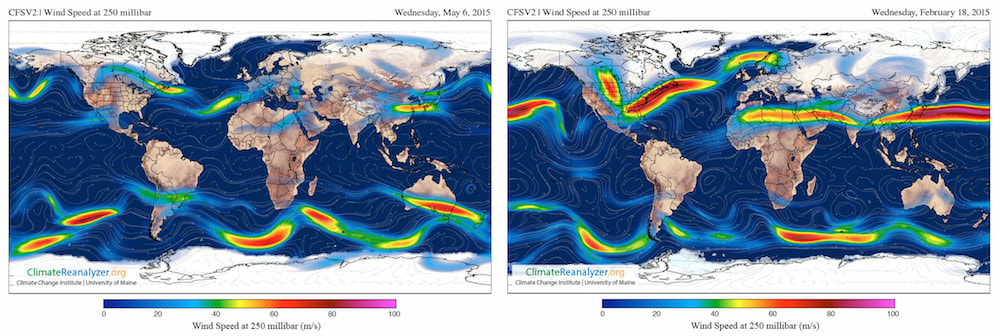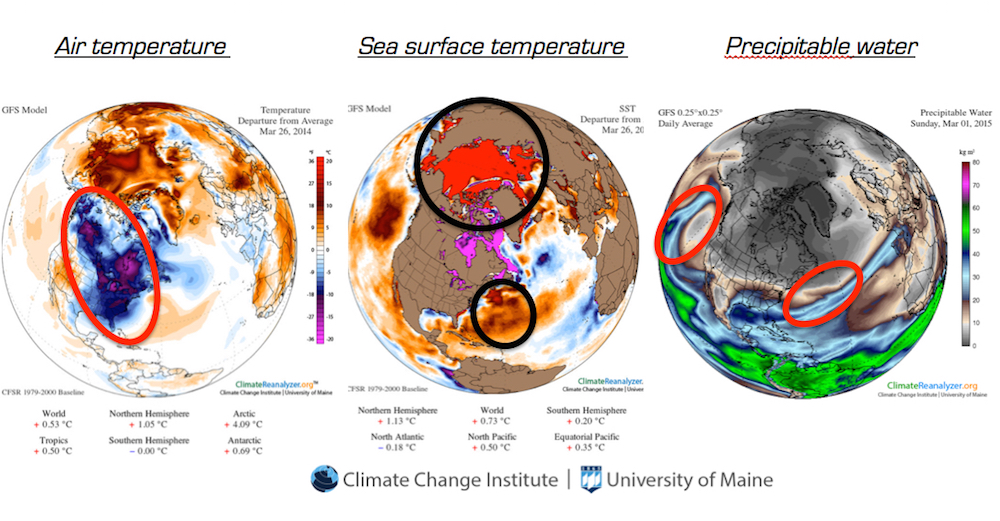|
World-wide average temperatures are rising. But we have always expected pockets and regions where temperatures are either warmer or colder than average. Now, with warming underway, we are seeing where these pockets are forming, and northeastern North America is turning out to be a cooling region. So what’s happening here? Even a small amount of warming soon yields a lot of warming in the Arctic where the bright-white and reflective sea ice melts and exposes the darker, sun-light absorbing water. Though a visit to the high Arctic might still require warm clothing, temperatures have risen dramatically relative to the norm and consequently the temperature difference between the Arctic and mid-latitudes has gotten smaller. We say that the temperature gradient has weakened. And a weaker temperature gradient doesn’t confine the Arctic Jet Stream to a narrow north-south band the way a stronger gradient does. That is, it meanders more, heading farther north and south on its eternally eastward flow.  Left: an illustration of the Arctic Jet Stream in its more "zonal", less meandering flow (windspeed at 250 mbar height, May 6, 2015) . Right: an illustration of the now-more-common flow with deeper meanders and stronger north-south wind speeds in the Pacific and over northeastern North America (windspeed at 250 mbar height, Feb 18, 2015). Both plots from Climate Change Institute's Climate Reanalyzer. Over the past two boreal winters, this increased meandering has included a northward meander in the Central Pacific, far enough west to put the western U.S. into severe drought, and a southward meander over northeastern North America bringing cold and snow.  Regional features of climate change observed in the Northern Hemisphere; shown here from conditions on Mar 26, 2014 compared to the average conditions from 1979 to 2000. Air temperatures over most of the Northern Hemisphere are warmer, with Arctic temperatures much warmer, and temperatures over northeaster North America much cooler than the 1979 to 2000 average. Arctic sea surface temperatures are also much warmer than the average as newly exposed sea water absorbs sunlight, and the north eastern Pacific and north western North Atlantic are also significantly warming. Precipitation is occurring farther east in the Pacific, not over the western U.S., and throughout southeastern and eastern North America. From Climate Reanalyzer. As we discovered in the GISP2 ice core, when climate changes abruptly it often begins with abrupt shifts in atmospheric circulation: we are now getting to see such a change in our own time; a result of our own, human-caused rapid climate change. It is scientifically fascinating. So long as one doesn’t think about the human, ecosystem, economic, and security devastation it represents.
Comments are closed.
|
 RSS Feed
RSS Feed